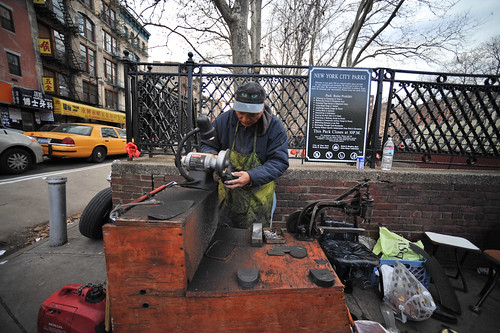
Not directly in conversation, but in the topics that happen between people, especially when they share the same studio space (as well as the same city), Mr. Chipchase’s posting about his ACM CHI keynote had me dig this dispatch out of the “pending drafts” depot of the blog (where it’s been sitting since last year, pondering itself and fermenting..) Between re-re-reading Jan’s post, and being asked last weekend at a family gathering by a friend of the family who I had never met — what do you do? — and thence answering by getting another beer and telling a short story about a guy, justified in his over education, wearing a janitor’s shirt with his name and Near Future Laboratory emblazoned on the back, with a diploma signed by The Terminator an iPhone in his pocket and a paycheck from Nokia, etc. — I thought it was time to ask myself again — what have I become?. Perhaps the sort like Jan, myself and the countless others who operate in between things, the question is better put in the more ontological tense — what am I always becoming?. The answers for me are always the stories, not (job) titles.
Crossing into a new practice idiom, especially if it offers the chance to feel the process of learning, is a crucial path toward undisciplinarity. The chance to become part of a practice — with all of its history, ideology, languages, norms and values, personalities, conferences — is an invigorating process. Embodying multiple practices simultaneously is the scaffolding of creativity and innovating, in my mind. It is what allows one to think beyond the confines of strict disciplinary approaches to creating new forms of culture — whether objects, ideas or ways of seeing the world.
I’ve been an engineer, working on the Motorola 88000 RISC processor at Data General back in the day. I studied how to think about the “human factor” as an engineering problem while I was working at the Human Interface Technology Lab at the University of Washington where I got my MSEng. The human factor has a less instrumental side, I discovered — it’s not just median heights and inter-ocular distances. So, I went to study culture theory and history of ideas at UC Santa Cruz where I got my Ph.D. I wanted to understand how people make meaning of the (technology-infused) world around them. Shortly after that, and quite accidentally, I entered the art-technology world when I recognized that I could do a form of “research” that was simultaneously technical and cultural. Four years in academia on the other side of the lectern provided a useful opportunity to try a different way of circulating knowledge, and a different set of constraints on what can and cannot be done in the area of practice-as-theory.

These disparate practices actually have a satisfying arc, in my opinion. It’s a combination of instrumental and practical skill, together with a sense of the meaning-making, theory and aesthetic possibilities of mostly technical and engineered objects.
Objects, I have learned, are expressive bits of culture. They make meaning, help us understand and make sense of the world. They are knowledge-making, epistemological functionaries. They frame conversations and are also expressions of possibility and aspiration. In many ways, they are some of the weightiest and expressive forms of culture we have. Being able to make objects and understand them as expressive, as able to tell or start or frame larger conversations and stories about the world is very satisfying.
Objects express the cultural, aesthetic, practical knowledge of their making — in their “design”, and in their crafting as “art”, or also in their “engineering.”
This is not a revelation for most of you, of course. For me, though, it has been a revelation to understand this kind of statement from the perspectives of multiple practices or disciplines.
Objects and culture are reciprocally embodied, certainly. But what object? And what culture? Certainly not one solidified, rock-solid meaningful object. If I take a phone (there are lots around me nowadays) and try to understand it, it matters from what “culture” (or discipline, or community-of-practice) I study it. At the same time, making an object, and how it is made, and what it will mean, and when I will know it is finished — all of these things depend on what culture or practice or body of knowledge from which you choose to look at it.
Put an engineer, a model-maker, an industrial designer, a marketing guy all around a table, staring at a phone. What will they see? Where will they agree on what they see and where will they look blankly and wonder — what is that guy talking about? How much time is spent — minutes? months? — negotiating what is seen?
What practices fit in the middle? Is that inter-disciplines? And what practices run across many? Is that multi-discplines? Do trans-disciplines work above and beyond? What about undisciplinary? What way of seeing that object will make it into something new and unheard of? What way of seeing will materialize new objects, innovative ideas and conversations that create new playful, more habitable near future worlds? (And not just smart refrigerators and clothes hangers that automatically dry clean your shirts, or whatever.)
What are your stories?
Continue reading Gradually Undisciplined. Stories Not Titles.